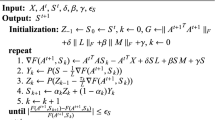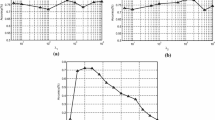Abstract
Dimension reduction is a challenge task in data processing, especially in high-dimensional data processing area. Non-negative matrix factorization (NMF), as a classical dimension reduction method, has a contribution to the parts-based representation for the characteristics of non-negative constraints in the NMF algorithm. In this paper, the NMF algorithm is introduced to extract local features for dimension reduction. Considering the problem of which NMF is required to define the number of the decomposition rank manually, we proposed a rank-adaptive NMF algorithm, in which the affinity propagation (AP) clustering algorithm is introduced to determine adaptively the number of the decomposition rank of NMF. Then, the rank-adaptive NMF algorithm is used to extract features for the original image. After that, a low-dimensional representation of the original image is obtained through the projection from the original images to the feature space. Finally, we used extreme learning machine (ELM) and k-nearest neighbor (KNN) as the classifier to classify those low-dimensional feature representations. The experimental results demonstrate that the decomposition rank determined by the AP clustering algorithm can reflect the characteristics of the original data. When it is combined with the classification algorithm ELM or KNN and applied to handwritten character recognition, the proposed method not only reduces the dimension of original images but also performs well in terms of classification accuracy and time consumption. A new rank-adaptive NMF algorithm is proposed based on the AP clustering algorithm and the original NMF algorithm. According to this algorithm, the low-dimensional representation of the original data can be obtained without any prior knowledge. In addition, the proposed rank-adaptive NMF algorithm combined with the ELM and KNN classification algorithms performs well.



Similar content being viewed by others
References
R.E. Bellman, Adaptive control processes: a guided tour, Princeton university press; 2015.
Keogh E, Mueen A. Curse of dimensionality. Ind.Eng.Chem. 2017;29(1):48–53.
Griparis A, Faur D, Datcu M. Dimensionality reduction for visual data mining of earth observation archives. IEEE Geoscience & Remote Sensing Letters. 2016;13(11):1701–5. https://doi.org/10.1109/LGRS.2016.2604919.
Travieso CM, Alonso JB. Special issue on advanced cognitive systems based on nonlinear analysis. Cogn Comput. 2013;5(4):397–8. https://doi.org/10.1007/s12559-013-9237-9.
Dan K. A singularly valuable decomposition: the SVD of a matrix. College Mathematics Journal. 1996;27(1):2–23.
Malkomes G, Brito CEFD, Gomes JPP. A stochastic framework for K-SVD with applications on face recognition. Pattern Analysis & Applications. 2016;20(3):1–10.
Hu Y, Yang M. Face recognition algorithm based on algebraic features of SVD and KL projection. In: International conference on robots and intelligent system 2016. Zhangjiajie: IEEE; 2016. p. 193–6.
Al-Anzi F S, Abuzeina D. Toward an enhanced Arabic text classification using cosine similarity and latent semantic indexing. Journal of King Saud University - Computer and Information Sciences. 2017;29(2):189–195.
Yu D, Chen N, Jiang F, et al. Constrained NMF-based semi-supervised learning for social media spammer detection. Knowl-Based Syst. 2017;125(C):64–73.
Liao Q, Zhang Q. Local coordinate based graph-regularized NMF for image representation. Signal Process. 2016;124:103–14. https://doi.org/10.1016/j.sigpro.2015.09.038.
Sunnydayal KK, Cruces S. An iterative posterior NMF method for speech enhancement in the presence of additive Gaussian noise. Neurocomputing. 2017;230:312–5. https://doi.org/10.1016/j.neucom.2016.12.012.
Cai D, He X, Han J, Huang TS. Graph regularized nonnegative matrix factorization for data representation. IEEE Transactions on Pattern Analysis & Machine Intelligence. 2011;33(8):1548–60. https://doi.org/10.1109/TPAMI.2010.231.
Kwon K, Shin JW, Kim NS. NMF-based speech enhancement using bases update. IEEE Signal Processing Letters. 2015;22(4):450–4. https://doi.org/10.1109/LSP.2014.2362556.
Yazawa S, Hamanaka M, Utsuro T. Novel approach to separation of musical signal sources by NMF. In: IEEE International conference on signal processing 2014. HangZhou: IEEE; 2015. p. 610–5.
Du R, Kuang D, Drake B, et al. DC-NMF: nonnegative matrix factorization based on divide-and-conquer for fast clustering and topic modeling. J Glob Optim. 2017;68:1–22.
Vital JPM, Faria DR, Dias G, et al. Combining discriminative spatiotemporal features for daily life activity recognition using wearable motion sensing suit. Pattern Analysis & Applications. 2017;20(4):1179–94.
Ge J, Zhou T, Zhang F, et al. Learning part-based dictionary by sparse NMF for face gender recognition. In: International symposium on computational intelligence and design 2015. Hangzhou: IEEE; 2015. p. 375–378.
Liao Q, Zhang Q. Local coordinate based graph-regularized NMF for image representation. Signal Process. 2016;124:103–14. https://doi.org/10.1016/j.sigpro.2015.09.038.
Han M, Liu B. Ensemble of extreme learning machine for remote sensing image classification. Neurocomputing. 2015;149(PA):65–70.
Brunet JP, Tamayo P, Golub TR, Mesirov JP. Metagenes and molecular pattern discovery using matrix factorization. Proc Natl Acad Sci. 2004;101(12):4164–9. https://doi.org/10.1073/pnas.0308531101.
Li SZ, Hou XW, Zhang HJ, et al. Learning spatially localized, parts-based representation. In: IEEE conference on computer vision and pattern recognition 2001. Kauai: IEEE; 2001. p. 207–212.
Xu W, Liu X, Gong Y. Document clustering based on non-negative matrix factorization. In: Proceedings of the twenty-sixth annual international ACM SIGIR conference on research and development in information retrieval 2003. Toronto: ACM; 2003. p. 267–73.
Lee DD, Seung HS. Learning the parts of objects by non-negative matrix factorization. Nature. 1999;401(6755):788–91. https://doi.org/10.1038/44565.
Babaee M, Tsoukalas S, Babaee M, Rigoll G, Datcu M. Discriminative nonnegative matrix factorization for dimensionality reduction. Neurocomputing. 2015;173(P2):212–23.
Linh NV, Anh NK, Than K. An effective NMF-based method for supervised dimension reduction. Advances in Intelligent Systems and Computing. 2015;326:93–104.
Liu H, Wu Z, Cai D, et al. Constrained nonnegative matrix factorization for image representation. IEEE Transactions on Pattern Analysis & Machine Intelligence. 2012;34(7):1299–311. https://doi.org/10.1109/TPAMI.2011.217.
Ding C, Li T, Jordan MI. Convex and semi-nonnegative matrix factorizations. IEEE Transactions on Pattern Analysis & Machine Intelligence. 2010;32(1):45–55. https://doi.org/10.1109/TPAMI.2008.277.
Zdunek R. Improved convolutive and under-determined blind audio source separation with MRF smoothing. Cogn Comput. 2013;5(4):493–503. https://doi.org/10.1007/s12559-012-9185-9.
Liu H, Sun F. Discovery of topical objects from video: a structured dictionary learning approach. Cogn Comput. 2016;8(3):519–28. https://doi.org/10.1007/s12559-015-9381-5.
Xu XZ, Ding SF, Shi ZZ, et al. Optimizing radial basis function neural network based on rough sets and affinity propagation clustering algorithm. Frontiers of Information Technology & Electronic Engineering. 2012;13(2):131–8.
Frey BJ, Dueck D. Clustering by passing messages between data points. Science. 2007;315(5814):972–6. https://doi.org/10.1126/science.1136800.
Y. Lecun, C. Cortes, The MNIST database of handwritten digits, http://yann.lecun.com/exdb/mnist/.
The USPS handwritten digit data, http://www-i6.informatik.rwth-aachen.de/~keysers/usps.html
Huang GB, Zhu QY, Siew CK. Extreme learning machine: theory and applications. Neurocomputing. 2006;70(1–3):489–501.
Cover T, Hart P. Nearest neighbor pattern classification. IEEE Trans Inf Theory. 1967;13(1):21–7. https://doi.org/10.1109/TIT.1967.1053964.
Acknowledgments
This work is supported by the Fundamental Research Funds for the Central Universities (No. 2015XKMS088)
Author information
Authors and Affiliations
Corresponding author
Ethics declarations
Conflict of Interest
Dong Shan, Xinzheng Xu, Tianming Liang, and Shifei Ding declare that they have no conflict of interest.
Informed Consent
Informed consent was not required as no human or animals were involved.
Human and Animal Rights
This article does not contain any studies with human or animal subjects performed by the any of the authors.
Rights and permissions
About this article
Cite this article
Shan, D., Xu, X., Liang, T. et al. Rank-Adaptive Non-Negative Matrix Factorization. Cogn Comput 10, 506–515 (2018). https://doi.org/10.1007/s12559-018-9546-0
Received:
Accepted:
Published:
Issue Date:
DOI: https://doi.org/10.1007/s12559-018-9546-0




